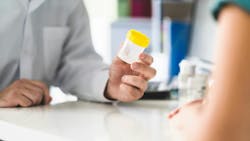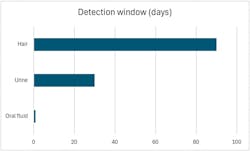With more than 230,000 positive drug tests since 2020, how the trucking industry detects drivers’ drug use is an important topic.
Currently, Department of Transportation drug testing relies entirely on urinalysis. Yet, many alternatives exist that the industry could use. These other testing methods have significantly different collection procedures and detection windows.
How do the different types of drug tests compare, and what is holding these alternative methods back?
See also: Trucking’s hair testing wait rolls on
How do drug tests determine drug use?
Drug tests take a person’s biological sample and run tests to find incriminating chemicals.
The details behind a drug test—what sample to take, which tests to run, which chemicals to find—can vary widely. For trucking, the drug tests that matter most are those required by DOT.
Under DOT guidelines, the sample can be a person’s urine or oral fluid sample, the tests are forms of immunoassay and mass spectrometry by a certified lab, and the incriminating chemicals are five major classes of psychoactive drugs.
What are the primary forms of drug tests for trucking?
When the trucking industry discusses drug testing methods, the discourse generally focuses on the types of biological samples that labs process. The type of sample is a major factor in the complexity of sample collection and in drug detection windows.
The main drug tests in trucking use urine, oral fluid, or hair samples.
To compare drug testing methods' detection windows, marijuana detection is a helpful common factor. Marijuana is exploding in popularity, and it is the greatest contributor to positive Clearinghouse drug tests.
Urine testing, or urinalysis, is the traditional drug test. A wide range of laboratories are certified to perform urine tests. Urine tests can detect marijuana use from within one to 30 days of use, according to Quest Diagnostics.
Oral fluid testing has a shorter detection window and is very close to becoming the first federal alternative to urinalysis. DOT officially sanctioned oral fluid testing in June 2023. Oral fluid tests can detect marijuana use within 24 hours of use, according to Quest Diagnostics.
Hair testing has the longest detection window. The method has been long-awaited by the trucking industry.
Hair testing shows “significant promise” for uncovering drug use, according to Mark Savage, chairman of American Trucking Associations’ Law Enforcement Advisory Board and Drivewyze's director of connected truck solutions.
See also: Trucking and law enforcement seek common ground
“The hair testing will be more accurate for a longer period of time, so your window is longer. From a DOT perspective, that’s particularly valuable,” Savage told FleetOwner. “It [Marijuana] may not be present in their system if they have to perform a urinalysis 35 days after smoking marijuana. Whereas in hair follicle testing, it could be there up to 90 days.”
Hair testing can detect marijuana use within one to three months, according to Quest Diagnostics. This wider window has the best chance of detecting whether a driver has a history of marijuana use.
Sample collection itself is another critical factor among these drug testing options. Some sample collections require more effort than others.
“With urinalysis and blood testing, the collection is a bit more complex,” Savage explained. “You have to have a facility where the urine can be collected, and it can be a bit challenging getting someone there and getting the test done, whereas hair follicle testing is really just taking a piece of the sample.”
With the largest detection window and a relatively non-invasive sample collection procedure, hair testing makes a lot of sense.
Many carriers, such as Schneider (No. 6 on the 2024 FleetOwner 500), employ their own drug testing protocols to screen drivers in addition to DOT-mandated testing. For large trucking companies, hair follicle testing is a popular approach.
Why is urine testing still the only method for DOT?
Urine testing is still the only real testing method for DOT compliance. Hair and oral fluid testing both appear headed on the path to federal implementation but face unique institutional blockages from the Department of Health and Human Services.
Oral fluid testing has a federal lab certification problem. After approving it in a final rule in mid-2023, DOT technically accepts both urine and oral fluid tests. For employers to use oral fluid testing, however, HHS must certify at least two laboratories. According to Safety and Health Magazine, no laboratory is certified yet to conduct oral fluid drug testing.
Hair testing is missing key federal guidelines. For nine years, hair testing has waited on guidance from HHS before the method can get any closer to DOT-approved use. The federal government first directed HHS to develop hair testing guidelines for DOT drug testing in 2015.
HHS did publish some guidance on hair testing in 2020 but with a stipulation that it be followed by a urine test. Lawmakers continue to pressure HHS to establish guidance for using hair testing as an alternative testing method for the transportation industry.
About the Author
Jeremy Wolfe
Editor
Editor Jeremy Wolfe joined the FleetOwner team in February 2024. He graduated from the University of Wisconsin-Stevens Point with majors in English and Philosophy. He previously served as Editor for Endeavor Business Media's Water Group publications.


